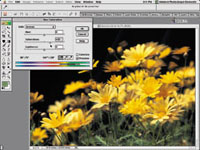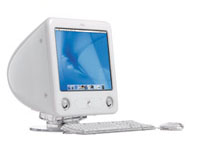Apples eMac Computer
Is This The Ultimate Affordable Digital Darkroom
In my e-mail not long ago
I received an announcement from Apple Computer about their newest computer
offering for the educational market--the eMac. This new model was
designed specifically for students in classrooms and featured a flat
17" CRT monitor and a powerful G4 processor with all of the computer
components built into the monitor housing, like the iMac before it.
In addition, the eMac features a CD-RW drive for both reading and burning
discs, two FireWire ports, five USB ports, an RJ-45 network 10/100BASE-T
network connector, as well as built-in support for AirPort wireless
connection. There's also a built-in 56K modem with phone line
connector, and even a mini-VGA video output for a second monitor. I
only had to think about this new educational model Apple computer a
moment to realize that at just over $1000 it would provide an ideal
basis for an affordable digital darkroom. However, my expression of
interest to Apple's PR department was answered by a notice that
the eMac would only be available to educational institutions. |
|||
What Makes A Computer Ideal
For The Digital Darkroom? |
|||
Getting Acquainted With
The eMac Test Run Evaluation And Recommendation |
|||
Ulead Photo Explorer 2.0
For The Mac |
|||
Processor And Memory:
700MHz PowerPC G4 processor with Velocity Engine; 256K on-chip level 2
cache at full processor speed; 100MHz system bus; 128MB SDRAM; two 168-pin
DIMM slots support up to 1GB using 128MB, 256MB, or 512MB DIMMs |
- Log in or register to post comments






































